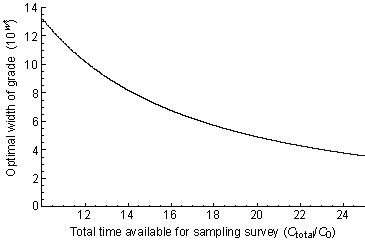By a grading method, we classify the infestation level into grades depending on
the number of individuals and record the grade of infestation without recording
the number of individuals. However, the resultant grade has no clear meaning and
hence it currently has only limited use. There are two questions that should be
solved to construct a grading method that yields a meaningful grade. (1) Which
scale should we use to determine the boundary of grades? For example, is a logarithmic
scale such as that divided at x = 1, 10, 100, 1000 preferable to an arithmetic
scale such as that divided at x = 50, 100, 150, 200? (2) Which grade width should
we use? When we use a logarithmic scale, for example, is a 5-times width such
as that divided at x = 1, 5, 25, 125 preferable to a 10-times width such as that
divided at x = 1, 10, 100, 1000? For the first question, we suggest that we should
utilize the scale that improves homoscedasticity to perform ANOVA. For the second
question, we provide a procedure to determine the optimal grade width.

Figure 1. Decrease in the optimal width of grade with increasing
amount of time available for sampling.